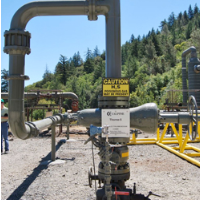EPA Does a Lousy Job Overseeing State Regulation of Fracking Injection Wells
 Fracking waste injection well (photo: Flickr-kqedquest)
Fracking waste injection well (photo: Flickr-kqedquest)
A federal government watchdog agency criticized the U.S. Environmental Protection Agency (EPA) this week for its poor oversight of state agencies that are doing a lousy job inspecting oil and gas fracking operations that pump waste water back into the ground, sometimes in sensitive areas.
The Government Accountability Office (GAO) looked at California and seven other states and found the same lax oversight of injection wells that ProPublica found in a 2012 investigation. The GAO report (pdf) said that the EPA doesn’t conduct annual on-site evaluations with any regularity and hasn’t updated its guidelines to the states since the 1980s.
The result is that “safeguards do not address emerging underground injection risks, such as seismic activity and overly high pressure in geologic formations leading to surface outbreaks of fluids.”
The oil and gas industry uses injection wells to dispose of waste water regurgitated during drilling that uses fracking and other extraction techniques. Fracking liberates otherwise unreachable deposits by blasting pressurized water, chemicals and other materials into the ground. The drilling often uses undocumented chemicals that can be harmful to groundwater sources. Forcible extraction has also been linked to earthquakes, sinkholes and air pollution.
California is just beginning efforts to regulate fracking. The technique has been around for decades but new technology has greatly expanded its use. Earlier this month, state regulators shut down 11 injection wells because of fear they may be contaminating aquifers in the Central Valley.
The EPA oversees 172,000 Class 2 wells, which involve fluid injections either to liberate oil and gas or discard the waste water used in the drilling. The GAO used that number, although it said the EPA keeps poor records on just what Class 2 wells are out there. The wells pump at least 2 billion gallons of fluids into the ground daily. That can be problematic in drought areas like California.
The toxic chemicals, hazardous waste and radioactive minerals are supposedly pumped deep into the ground, far from groundwater. At lease that’s the way it’s supposed to work. ProPublica has reported on water straying far from its original source and, in some cases, bubbling to the surface.
Texas has the largest number of Class 2 wells (52,977), according to the GAO, followed by California (49,783), Oklahoma (11,134), Kentucky (3,221), Ohio (2,439), Pennsylvania (1,865), North Dakota (1,290) and Colorado (901).
Only 64% of the California wells were reported inspected in fiscal year 2012. That was better than Texas (41.4%), Kentucky (34.3%), Pennsylvania (33%) and Oklahoma (20%). Those low percentages may have contributed to the consensus among the eight states that instances of “significant violations” were rare.
California only found 24 instances of alleged contamination during the five years between 2008 and 2012, including a pristine 2008 and 2011. Nine of the 12 instances in 2010 reportedly came from one operator illegally injecting into multiple wells. Five of the states had no problems.
The GAO partially blamed insufficient funding at the state and federal level for the lack of proper oversight. The EPA agreed with the report’s findings.
–Ken Broder
To Learn More:
Report Criticizes EPA Oversight of Injection Wells (by Naveena Sadasivam, ProPublica)
Congressional Watchdog Urges EPA to Step Up Actions on Fracking (by Michael, Muskal, Los Angeles Times)
State Shuts Down Fracking Waste Injection Sites as Possible Threats to Aquifers (by Ken Broder, AllGov California)
EPA Program to Protect Underground Sources from Injection of Fluids Associated With Oil and Gas
Production Needs Improvement (U.S. Government Accountability Office) (pdf)
- Top Stories
- Controversies
- Where is the Money Going?
- California and the Nation
- Appointments and Resignations
- Unusual News
- Latest News
- California Forbids U.S. Immigration Agents from Pretending to be Police
- California Lawmakers Urged to Strip “Self-Dealing” Tax Board of Its Duties
- Big Oil’s Grip on California
- Santa Cruz Police See Homeland Security Betrayal in Use of Gang Roundup as Cover for Immigration Raid
- Oil Companies Face Deadline to Stop Polluting California Groundwater





